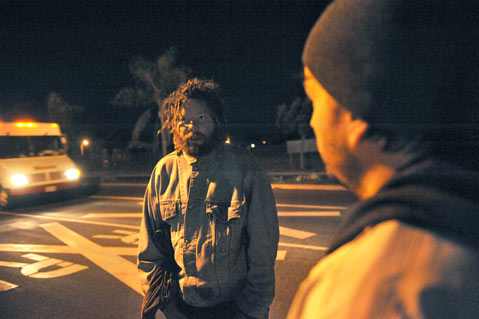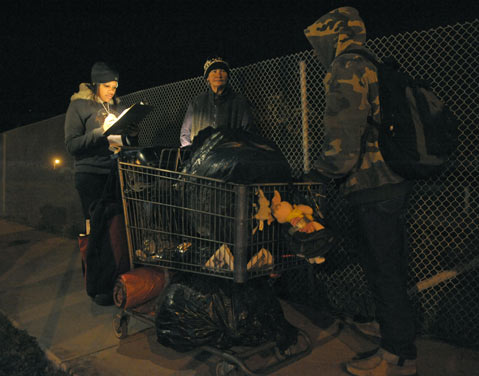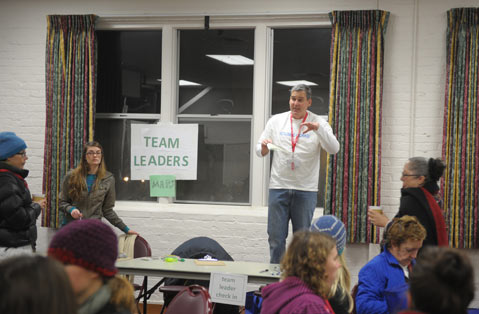Half Empty or Half Full?
New Survey Shows Drop in South Coast Homeless Population

The good news is that there seem to be fewer homeless people living throughout Santa Barbara County than there were two years ago. In the City of Santa Barbara, the numbers fell more markedly, by 109 people. But statistics — like beauty — lie in the eye of the beholder, and what these figures actually mean is open to interpretation, conjecture, and considerable controversy.
Known for certain is that more than 600 volunteers got up before the crack of dawn on January 22 and 23 and went looking for homeless people throughout the county to count, interview, and categorize as part of a special homeless census required every two years by the federal government for communities receiving homeless assistance grants. Even though about 100 more volunteers participated in this year’s effort than the one conducted in 2011, the numbers were down slightly overall. This year, volunteers “encountered” 1,466 homeless people (down 70 from the prior effort), interviewed 1,111 (down 23), and deemed 886 to qualify as “vulnerable” (down 46), meaning the stresses and strains of their circumstances place them at risk of premature death.

The numbers, however, were hardly uniform throughout the county. Santa Maria saw a 5 percent increase in the number of homeless contacts. By contrast the City of Santa Barbara — where roughly two-thirds of the county’s counted homeless reside — saw relatively small but significant reductions. Between 2011 and now, the number of homeless contacted dropped by 100 and the number deemed to be vulnerable dropped by 109, from 640 to 531.
This shift could reflect how, when, and where the volunteers were deployed. It could reflect a random fluctuation or it could mean, as some have suggested, that the economy has improved and people pushed over the edge by the recession have gotten back on their feet. But Santa Barbara Mayor Helene Schneider suggested that City Hall’s new emphasis on restorative policing — in which two full-time cops, six “street outreach” workers, and six community hosts have been deployed to help keep the peace and better connect the indigent with available services — is paying off. Schneider, an enthusiastic advocate of the restorative approach, also suggested that a recent consolidation of the multiple political bureaucracies that minister to the homeless might be achieving improved efficiencies in service delivery.
“We’re doing a really poor job,” she said. “And we’re not going to arrest our way out of it.”
That new super homeless agency, known as the Central Coast Collaborative on Homelessness — or C3H for short — gave a thumbnail sketch of its survey results at a well-attended community forum held at the downtown library’s Faulkner Gallery this Monday afternoon. Much of the information confirmed general expectations: Two-thirds of the homeless counted were male; their average age was 43. Fourteen percent reported having lived in foster care. Another 14 percent were veterans. The oldest was 84. The average duration of their homelessness was 6.4 years. One-third reported being victimized by violence while homeless. Twenty-five percent managed to graduate from high school but went no further; another 25 percent didn’t make it to graduation. But 40 percent made it into college or graduate school. Fifty-five percent reported they were county residents before they became homeless, though it was not clear for how long. (Residency, when discussing the homeless, is always a political hot potato. In the most recent survey, no pre-homeless residency information was provided in 25 percent of the cases.)
Slightly more than half had alcohol abuse issues, 44 percent stated drug abuse, and 53 percent reported mental health concerns. Of those, 31 percent said they had serious mental health problems and 61 percent reported being treated for their psychological ailments. In the past year, 732 — about half — had visited the emergency room at least once, and 685 had been admitted to a hospital. One-third had no insurance of any kind. Nearly three-quarters said they’d spent time in jail sometime in their life, and 25 percent reported having been in state prison.
The C3H survey located 182 homeless families throughout the county, 122 of which were deemed “vulnerable.” Of these, 53 percent of the heads of household reported having mental health conditions, and 60 percent, substance abuse problems. Volunteers in Santa Maria found more homeless families than their counterparts in Santa Barbara. C3H organizers stressed that these counts do not provide definitive numbers, but rather a “point in time” snapshot of whom they could find. To get a better approximation of the true magnitude of homelessness, C3H organizers say the rule of thumb is to multiply the found number by three. How statistically valid that is remains untested, but the County Superintendent of Public School’s office stated there were 5,271 homeless schoolchildren in Santa Barbara County. Its definition of homelessness is far broader, however, including 4,801 students whose families are doubling up with others under the same roof.

The point of amassing such information is not merely to qualify for federal homeless assistance subventions — which, by the way, have dropped by $500,000 since last year — but to better target limited resources to those individuals most in danger. Not coincidentally, these individuals also happen to impose the greatest financial burden on county hospitals, jails, and social service agencies. The last homeless count, and attendant “Vulnerability Index,” helped guide the placement of 28 families and 53 individuals into affordable housing — 181 people in all.
The operating theory — held by political majorities on the County Board of Supervisors and the Santa Barbara City Council — is that by first getting the most vulnerable into housing, hence the name “Housing First,” health risks can be minimized, treatment more efficiently delivered, and the drain on public coffers reduced. Homelessness remains one of the great sore thumbs of Santa Barbara politics, and not all elected officials subscribe to this notion. Council conservative Dale Francisco, in the past, has expressed doubt that the greater efficiencies promised by this Housing First approach will stem the tide of homeless people seeking an inviting climate, a tolerant police department, and a generous nonprofit community. Sharon Byrne of the Milpas Community Association has expressed skeptical curiosity why Santa Barbara’s numbers haven’t gone even further down given that 181 homeless have reportedly been housed and that the Santa Barbara Police Department — through its restorative program — had placed 132 chronically homeless people either into programs or shelter and reunited another 32 with either family or friends.
The Housing First approach presupposes the existence of affordable housing into which the chronically homeless can be located. In the South Coast, where housing costs are notoriously astronomical, that’s always been a challenge. But now, it’s getting worse. According to Robert Pearson, director of the City Housing Authority, vacancy rates have tightened up and rents — dormant during the recession — are beginning to rise. Likewise, he said, federal dollars for homeless and housing programs were first hit by the latest budget and harder still by “sequestration,” the $85 billion budget cuts triggered by the impasse in Washington, D.C. Because of sequestration alone, Pearson said, his agency would lose 46 units’ worth of housing vouchers.
The other major challenge has been the chronic dearth of mental health services available to the poor. Many of the homeless, Pearson noted, are not equipped to make the transition from the streets and into housing without far more mental health care than is currently available. C3H organizer Angela Antenore lamented that so many mentally ill found their way into County Jail rather than the appropriate services. “We’re doing a really poor job,” she said. “And we’re not going to arrest our way out of it.”


